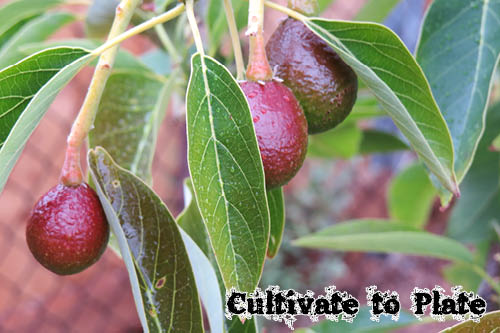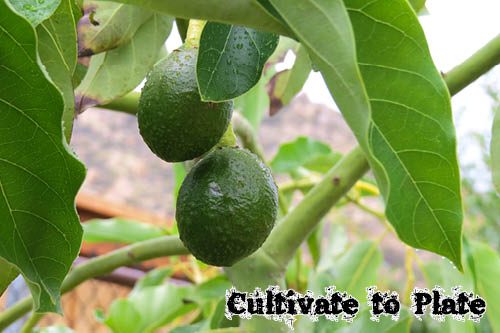Avocados: How to Grow, When to Pick, Best Ways to Ripen
Avocados come from evergreen fruit trees that like full sun and well drained soil. The fruit is creamy and is used more as a vegetable than as a sweet fruit.
Growing Avocado Trees
Avocados may be grown from the seeds, but the fruit may not come for a very long time (5 to 13 years) and the fruit may not be consistent – if the tree gets any fruit at all. It is always better to begin with a grafted tree if you are growing them for fruit – it will be an exact replica of its mother plant. Avocados grow best in soil with a pH of 6.0 to 6.5.
Avocado trees enjoy lots of water, but they are very prone to root rot which is why a well drained area is necessary for them. According to Gary S. Bender in the book “Avocado Production in California: Book 1”, the soil drainage is so important to success:
Avocado roots have few root hairs, making water uptake into the roots relatively inefficient. Therefore, avocados need plentiful soil moisture to grow, but excess free soil water (defined as a state is which drainage is impeded leaving excess water and little air between the soil particles) begins to suffocate roots and provides a medium for the zoospores of the root rot fungus Phytophthora cinnamomi to attack the roots. Even without the fungus, avocado roots will begin to die from lack of oxygen after 48 hrs of flooding.
Avocado trees are best planted where there is space for sunlight to reach between them to prevent fungal disease (moisture attracts fungus). Avocados need water, but too much water leads to disease. Therefore, constant monitoring of the plants is necessary especially during the active growing and fruiting seasons. A good plan is to soak the soil well when watering, and let the ground dry out (but not completely) before the next watering.
Large commercial avocado orchards will use tensiometers, meters that measure the soil moisture and will measure the amount of suction the roots have to exert to extract moisture from the soil – not the actual amount of water. These readings can help schedule irrigation times.
Two Main Varieties and Why Interplanting Them Is So Important
There are two main varieties of avocados: Type A (dark or ‘Guatemalan’) and Type B (green or ‘Mexican’). They are actually grouped by the time of the day that their flowers open and thusly are ready to be pollinated. Type A opens as a female in the morning, and Type B opens as a female in the afternoon. After each opens as a female, they change to a male flower, and if the pollinators are not present when the flowers are open, you’ll get a bad fruit set. Avocado trees self pollinate, and interplanting the different varieties will yield a better chance of successful pollination.

Growing Avocados From Seed
It is very easy if you want to start an avocado plant from seed. The California Avocado Commission recommends these steps:
- Remove the seed from the avocado and rinse it off.
- Insert 3 toothpicks into the seed, broad end down, and suspend it over a water filled glass that will cover about one inch of the seed.
- Place the seed and water in a warm place out of direct sunlight. The roots should start to immerge within 2 to 6 weeks, and the actual stem within about 8 weeks.
- When the stem has reached about 6 inches, cut it back to about 3 inches. When leaves have grown again and the roots have thickened, plant in a rich humus soil leaving the seed half exposed.
- Give it a deep soak occasionally, and keep the soil moist but not waterlogged. And at this point, give it lots of sunshine. Once the stem has reached about a foot, trim it back to 6 inches, which will encourage new plant shoots to form.
- This plant may be planted in a protected yet sunny area in the yard, or be kept as a potted plant in the house.
How Avocados Ripen and When to Pick Them
Avocados do not ripen on the tree – they mature. Avocados are best stored on the tree until they are ready to be picked then ripened off the tree. They are fully mature when they have the full amount of oil inside of them. Too much oil and they will turn rancid. To test whether or not the fruit is mature and ready to be picked, pick one or two and place in an area to let it ripen. If they are shriveled or are very rubbery, the oil content hasn’t reached optimum levels yet and the fruit isn’t ready. Wait a few weeks and try again. When picking, always leave a small amount of stem attached to the fruit.
To ripen the avocados once they’ve been picked, place them in a plain brown paper bag at room temperature until ripe, 2 to 5 days, checking each day. Setting the avocados on a counter near bananas or apples will help speed up the ripening process, too, due to the natural presence of ethylene gas in those fruits.
Once an avocado is fully ripe, they can be stored in the fridge for a few days until you are ready to eat them.
How to Preserve Avocados
If you have a lot of avocados and can’t eat them all at once, you can freeze them for later. Select avocados that are ripe and free from any dark internal blemishes. Remove the pit, and puree or mash the fruit (they don’t freeze well when they are halved, cut up, or sliced). Stir in 1 tablespoon fresh lemon juice for every two mashed avocados to keep their green color and help to stop the oxidation process. Alternately, add in 1/4 teaspoon of ascorbic acid to each quart of avocado puree. It will keep up to 6 months in the freezer.

Resources:
“Avocado Handbook – Growing Avocados in Ventura County.” University of California Cooperative Extension Ventura. University of California Division of Agriculture and Naural Resources, n.d. Web. 09 June 2015.
Bender, Gary S., ed. Avocado Production in California: A Cultural Handbook for Growers – Book One Background Information (n.d.): n. pag. Subtropical Fruit Crops of San Diego. University of California Cooperative Extension. Web. 9 June 2015.
“Edible Plants: Avocado, Growing.” UCCE Master Gardeners of Orange County, CA. UC Division of Agriculture and Natural Resources, n.d. Web. 09 June 2015.
“Freezing Avocados.” National Center for Home Food Preservation. University of Georgia, n.d. Web. 09 June 2015.
Goodwin, Ian. “How to Use Tensiometers.” Agriculture and Food. State Government of Victoria Department of Environment and Primary Industries, Sept. 2000. Web. 09 June 2015.
“Learn How to Grow Your Own Avocado Tree From Seed.” Grow Your Own Tree. California Avocado Commission, n.d. Web. 09 June 2015.
McLaughlin, Chris. “Growing Avocados.” Vegetable Gardener. Taunton Press, 9 Jan. 2010. Web. 09 June 2015.

You must be logged in to post a comment.